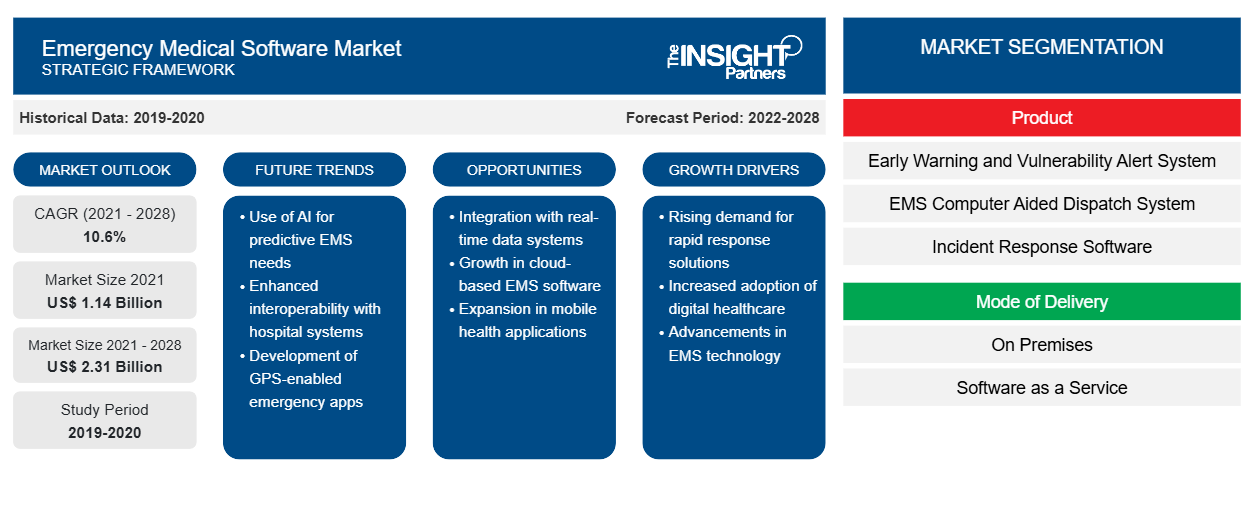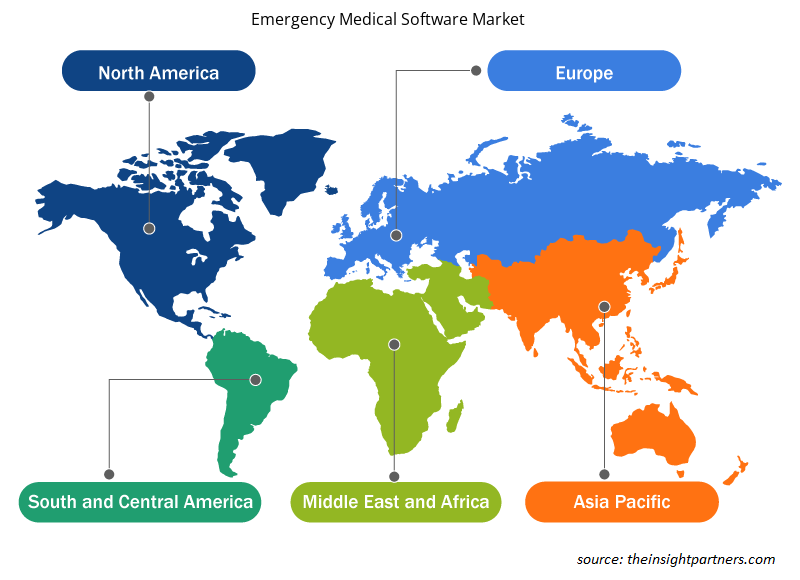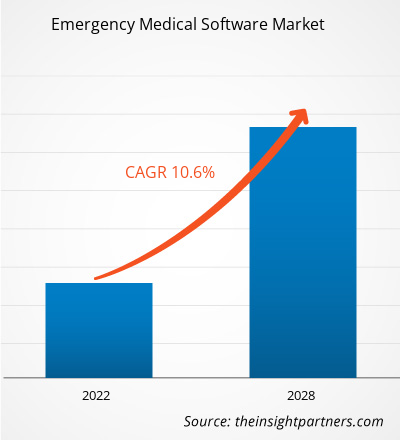The emergency medical software market is projected to reach US$ 2,313.20 million by 2028 from US$ 1,144.91 million in 2021; it is estimated to grow at a CAGR of 10.6% during 2021-2028.
Emergency medical software is used to respond to medical incidents and provides emergency medical care. EMS focuses on the emergency medical care of the patient(s) if any incident causes severe illness or injury. EMS is a coordinated response system and emergency medical care involving multiple people and agencies. A comprehensive EMS system consists of incident recognition, access 911, dispatch, and prevention awareness.
The emergency medical software market is segmented on the basis of product, mode of delivery, platform, end user, and geography. The market, by geography, is broadly segmented into North America, Europe, Asia Pacific, the Middle East & Africa, and South & Central America. The emergency medical software market report offers insights and in-depth analysis of the market, emphasizing parameters such as emergency medical software market size, market trends, technological advancements, and market dynamics, along with the analysis of the competitive landscape of the globally leading market players.
Customize This Report To Suit Your Requirement
You will get customization on any report - free of charge - including parts of this report, or country-level analysis, Excel Data pack, as well as avail great offers and discounts for start-ups & universities
Emergency Medical Software Market: Strategic Insights

- Get Top Key Market Trends of this report.This FREE sample will include data analysis, ranging from market trends to estimates and forecasts.
You will get customization on any report - free of charge - including parts of this report, or country-level analysis, Excel Data pack, as well as avail great offers and discounts for start-ups & universities
Emergency Medical Software Market: Strategic Insights

- Get Top Key Market Trends of this report.This FREE sample will include data analysis, ranging from market trends to estimates and forecasts.
The growth of the emergency medical software market is attributed to the increasing cases of trauma injuries and rising healthcare expenditure. However, shortage of skilled professionals restricts the market growth.
Market Insights
Increasing Cases of Trauma Injuries
Medical emergencies, such as road traffic injuries, are one of the leading causes of death across the globe. According to the World Health Organization (WHO), in 2021, road traffic injuries led to ~1.3 million deaths. Moreover, more than half of all road traffic deaths are among pedestrians, cyclists, and motorcyclists. Additionally, the WHO stated that 93% of the world's fatalities on the road occur in low and middle-income countries. It is anticipated that road traffic injuries are the major cause of death for children and young adults aged 5–29 years. Moreover, driving vehicles under the influence of alcohol and any psychoactive substances or drugs increases the risk of a crash, which results in death or serious injuries. This is one of the major driving factors contributing to the surging demand for proper medical emergency systems, such as incident response systems and ambulance management software.
In 2021, the WHO stated that noncommunicable diseases accounted for 41 million deaths, which is ~71% of all the fatalities globally. Additionally, Global Burden of Disease in 2019 reported ~2.46 billion disability-adjusted life years (DALYs) per year. These fatalities occur due to premature deaths and prolonged disabilities. Moreover, it is also expected that as per one estimate, more than 50% of deaths and 40% of the total burden of disease in low and middle-Income countries could be avoided with prehospital and emergency care. In addition, global total addressable deaths and DALYs that can be avoided amount to 24.3 million and 1,023 million lives, respectively. In South Asia, 90% of deaths and 84% of DALYs are due to emergency and trauma conditions. Thus, the rising cases of trauma propel the growth of the emergency medical software market.
Product-Based Insights
The global emergency medical software market, based on product, is segmented into early warning & vulnerability alert system (EWVAS), EMS computer aided dispatch (CAD) system, incident response software, ambulance management software, and others. The incident response software segment held the largest market share in 2021. Moreover, the same segment is anticipated to register the highest CAGR in the market during the forecast period, as the product is used most commonly in practice.
Mode of Delivery-Based Insights
The global emergency medical software market, based on mode of delivery, is bifurcated into on premise and software-as-a-service (SaaS). The on premise segment held a larger market share in 2021. However, the SaaS segment is anticipated to register a higher CAGR during 2021–2028 due to a higher deployment of cloud-based SaaS system and solutions than on premise solutions.
Platform-Based Insights
The global emergency medical software market, based on platform, is segmented into windows, android, iOS, and others. The windows segment held the largest share of the market in 2021. Moreover, the same segment is anticipated to register the highest CAGR in the market during the forecast period.
Emergency Medical Software Market Regional Insights
The regional trends and factors influencing the Emergency Medical Software Market throughout the forecast period have been thoroughly explained by the analysts at The Insight Partners. This section also discusses Emergency Medical Software Market segments and geography across North America, Europe, Asia Pacific, Middle East and Africa, and South and Central America.

- Get the Regional Specific Data for Emergency Medical Software Market
Emergency Medical Software Market Report Scope
| Report Attribute | Details |
|---|---|
| Market size in 2021 | US$ 1.14 Billion |
| Market Size by 2028 | US$ 2.31 Billion |
| Global CAGR (2021 - 2028) | 10.6% |
| Historical Data | 2019-2020 |
| Forecast period | 2022-2028 |
| Segments Covered |
By Product
|
| Regions and Countries Covered | North America
|
| Market leaders and key company profiles |
Emergency Medical Software Market Players Density: Understanding Its Impact on Business Dynamics
The Emergency Medical Software Market is growing rapidly, driven by increasing end-user demand due to factors such as evolving consumer preferences, technological advancements, and greater awareness of the product's benefits. As demand rises, businesses are expanding their offerings, innovating to meet consumer needs, and capitalizing on emerging trends, which further fuels market growth.
Market players density refers to the distribution of firms or companies operating within a particular market or industry. It indicates how many competitors (market players) are present in a given market space relative to its size or total market value.
Major Companies operating in the Emergency Medical Software Market are:
- Quark Software
- Sun Ridge Systems, Inc.
- Trapeze Group
- Cerner Corporation
- GE Healthcare
Disclaimer: The companies listed above are not ranked in any particular order.

- Get the Emergency Medical Software Market top key players overview
End User-Based Insights
The global emergency medical software market, based on end user, is segmented into commercial, state city agencies, municipal, and others. The commercial segment held the largest share in 2021 and is estimated to register the highest CAGR in the market during the forecast period. The market for this segment is expected to witness a steady growth as commercial spaces are being developed under strict standards and guidelines that dictate the presence of early detection systems, incident response software, and others. Also, as private hospitals are a part of the segment, the market for the commercial segment is expected to see a steady growth in the coming years.
Product launches and approvals are commonly adopted strategies by companies to expand their global footprints and product portfolios. Moreover, the emergency medical software market players focus on the partnership strategy to enlarge their clientele, which, in turn, permits them to maintain their brand name across the world. The market share is anticipated to flourish with the development of new innovative products by market players.
Company Profiles
- Quark Software
- Sun Ridge Systems, Inc.
- Trapeze Group
- Cerner Corporation
- GE Healthcare
- CENTRALSQUARE
- Traumasoft
- AngelTrack LLC
- EMIS Health
- MEDHOST
- Epic Ems
Frequently Asked Questions
Who are the key players in the emergency medical software market?
The emergency medical software market majorly consists of the players such as Quark Software Inc., Sun Ridge Systems, Inc., Trapeze Group, Cerner Corporation, GE Healthcare, CENTRALSQUARE, Traumasoft, AngelTrack LLC, EMIS Health, MEDHOST, Epic EMS.
Which region is fastest growing?
Based on geography, the APAC region is accounted for highest CAGR in emergency medical software market during the forecast period.
Which segment led the emergency medical software market?
The incident response software segment under product segment, held the largest share in 2021.
What is emergency medical software?
Emergency medical software are solutions that are used by hospitals, healthcare professionals, first responders, and paramedics to aid a coordinated effort towards providing emergency services to the public. The software tracks time, patient records, billing, and vehicle management, among other tasks for public and private emergency medical departments and organizations to streamline emergency medical efforts.
- Historical Analysis (2 Years), Base Year, Forecast (7 Years) with CAGR
- PEST and SWOT Analysis
- Market Size Value / Volume - Global, Regional, Country
- Industry and Competitive Landscape
- Excel Dataset
- Parking Meter Apps Market
- eSIM Market
- Advanced Distributed Management System Market
- Online Exam Proctoring Market
- Electronic Data Interchange Market
- Barcode Software Market
- Maritime Analytics Market
- Cloud Manufacturing Execution System (MES) Market
- Robotic Process Automation Market
- Digital Signature Market
Testimonials
Reason to Buy
- Informed Decision-Making
- Understanding Market Dynamics
- Competitive Analysis
- Identifying Emerging Markets
- Customer Insights
- Market Forecasts
- Risk Mitigation
- Boosting Operational Efficiency
- Strategic Planning
- Investment Justification
- Tracking Industry Innovations
- Aligning with Regulatory Trends
Yes! We provide a free sample of the report, which includes Report Scope (Table of Contents), report structure, and selected insights to help you assess the value of the full report. Please click on the "Download Sample" button or contact us to receive your copy.
Absolutely — analyst assistance is part of the package. You can connect with our analyst post-purchase to clarify report insights, methodology or discuss how the findings apply to your business needs.
Once your order is successfully placed, you will receive a confirmation email along with your invoice.
• For published reports: You’ll receive access to the report within 4–6 working hours via a secured email sent to your email.
• For upcoming reports: Your order will be recorded as a pre-booking. Our team will share the estimated release date and keep you informed of any updates. As soon as the report is published, it will be delivered to your registered email.
We offer customization options to align the report with your specific objectives. Whether you need deeper insights into a particular region, industry segment, competitor analysis, or data cut, our research team can tailor the report accordingly. Please share your requirements with us, and we’ll be happy to provide a customized proposal or scope.
The report is available in either PDF format or as an Excel dataset, depending on the license you choose.
The PDF version provides the full analysis and visuals in a ready-to-read format. The Excel dataset includes all underlying data tables for easy manipulation and further analysis.
Please review the license options at checkout or contact us to confirm which formats are included with your purchase.
Our payment process is fully secure and PCI-DSS compliant.
We use trusted and encrypted payment gateways to ensure that all transactions are protected with industry-standard SSL encryption. Your payment details are never stored on our servers and are handled securely by certified third-party processors.
You can make your purchase with confidence, knowing your personal and financial information is safe with us.
Yes, we do offer special pricing for bulk purchases.
If you're interested in purchasing multiple reports, we’re happy to provide a customized bundle offer or volume-based discount tailored to your needs. Please contact our sales team with the list of reports you’re considering, and we’ll share a personalized quote.
Yes, absolutely.
Our team is available to help you make an informed decision. Whether you have questions about the report’s scope, methodology, customization options, or which license suits you best, we’re here to assist. Please reach out to us at sales@theinsightpartners.com, and one of our representatives will get in touch promptly.
Yes, a billing invoice will be automatically generated and sent to your registered email upon successful completion of your purchase.
If you need the invoice in a specific format or require additional details (such as company name, GST, or VAT information), feel free to contact us, and we’ll be happy to assist.
Yes, certainly.
If you encounter any difficulties accessing or receiving your report, our support team is ready to assist you. Simply reach out to us via email or live chat with your order information, and we’ll ensure the issue is resolved quickly so you can access your report without interruption.















The List of Companies - Emergency Medical Software Market
- Quark Software
- Sun Ridge Systems, Inc.
- Trapeze Group
- Cerner Corporation
- GE Healthcare
- CENTRALSQUARE
- Traumasoft
- AngelTrack LLC
- EMIS Health
- MEDHOST
- Epic EMS






 Get Free Sample For
Get Free Sample For